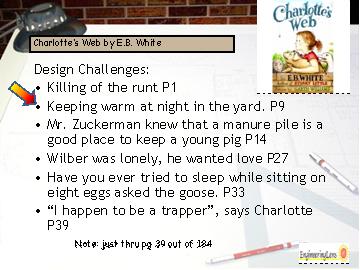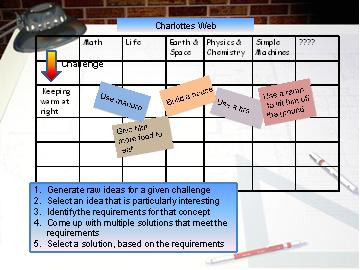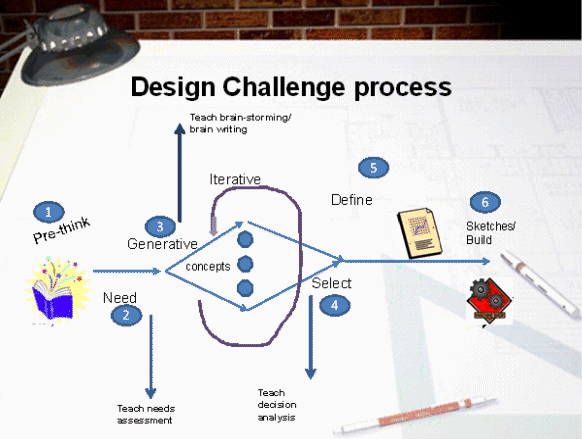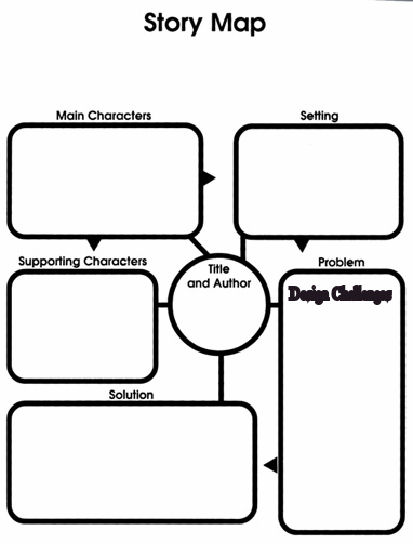|

Have a
question or comment?
Literacy can be expanded
by creating reports, journals, presentations and modification
to the story by the student. Both students and teachers see the connection
between all subjects when doing an engineering design project.
The projects are done as an inquiry based process,
with the team experience being an additional learning benefit.
|
Web Sites:
|
 |
|
|
Just within the
first 39 pages of the book, Charlotte’s Web there are many
challenges the students can find.
The
children can select one of the challenges and then brain
storm looking for ideas to solve the challenge. |
 |
| |
|
|
Here we
have a few ideas and their relationship to the state science
framework . Depending on what we want to learn, we can
create the requirement so that it favors one of the strands
of the framework. |
 |
 |
Shows the
process of reading a book to building a solution to the
design challenges found.
Also shows that you can create other learning
opportunities for the students. As an example the
students can learn about the "needs assessment strategy" you
would take to find the design challenge, understand the
values of the character and what constraints should be
imposed.
|
|
| |
Process
|
|
Define strategy |
Pick an additional science strand to connect;
-
earth
and space
- life science
-
physics and chemistry
|
|
Look at "story map" for ideas |
|
Develop design challenges |
Integrate the engineering design and the
science strand for the grade level
Inquire-based project teams
|
|
Reports and rubrics
|
|
We begin to enhance the learning process by using the
engineering design methodology as a connector between
literature, science & mathematics. Within this process
is an infusion of thinking skill strategies,
such as creative and critical thinking, questions and
meta-cognitive reflection. The concept uses the
existing comfort level of the elementary teachers and the
student’s natural engineering abilities.
The process begins with literature, such as
fairy tales, starting in the lower grades and leading to
more sophisticated stories at older ages – stories that
engage students. The underlining skills of the engineering
design process are related to the science process,
mathematical problem solving (process) and thinking skills.
Thus the student is taught how to think skillfully.
"Engineering design challenges" are created by actionable
items in the story and lead to inquiry based team projects
that have a design theme. As an example, in the story
"Island of the Blue Dolphins", the village leaves canoes on
the side of a hill for escaping a potential attack. The
heroine in the story has a difficult time getting one of
them down the hill and into the water. A "design challenge"
for the students could be to design a system to make it
easier for her to lower the canoe.
|
Picking literature:
use books to also cover the social
studies themes as defined in the framework. |
| When choosing your book, you can integrate
Social Studies/History by picking books with themes
that track the Social Studies/History Framework |
|
Pre-Kindergarten–Kindergarten:
Living, Learning, and Working Together |
|
Grade 1
:
True Stories and Folk Tales from America and from
Around the World |
|
Grade2:
E Pluribus Unum: From Many ,One |
|
Grade 3
:
Massachusetts and its Cities and Towns: Geography
and History
|
|
Grade 4
: North
American Geography with Optional
Standards for One Early Civilization |
|
Grade 5
:
United States History, Geography, Economics, and
Government: Early Exploration to Westward Movement
|
|
|
Preparation:
Pedagogy skills will allow
you to engage the students by; Modeling, Scaffolding,
Coaching, Reflecting and Fading. |
This lesson plan will give
you, the teacher, a great opportunity to work with your
students to become self learners. The process will allow
you and your students to connect at least three or four subject together so
you’re teaching across the curriculum and your students will
see the relevance of what they are learning.
They
will not be learning in a silo but you will be working with
the students in a constructionist approach. The concepts
used are based on Vygotski’s and Piagets’ approach to early
education.
|
|
Pre-existing
skills needed by the students; |
·
Understand
the design process and what engineers do.
·
What science
are we going to learn or have we just finished.
·
How to work as
a team (peer interaction).
·
Students
tutoring other students.
Starts with viewing
through the “Engineering Lens”
The students and teachers
should focus on thinking like an engineer when reading the
literature. Questions of the story line, author and
characters around the design of a product or process for
society should be the instrument to begin. We should invite
them to ask creative questions, make diverse observations,
explore multiple viewpoints, reflect on their thinking
process and seek personal connections of the literature.
Examples: Why is this a special moment for the
character in the story? How can we as engineers, created
something for the characters in the story that will make
their actions better?
|
|
Approach:
A teacher normal engages the
students with the literature they are reading by asking
skillful questions and using meta-cognitive reflection to
bring out interesting areas of the story line. What we are
adding is an engineering lens on the process to focus those
questions from an engineering designer’s viewpoint. |
|
Define an approach
for what you want the leaning outcome to be.
·
Do we
want to emphasize the learning of the engineering
design process?
·
Do we
want to focus on a science strand within a design
process?
·
Do we
want to focus on teaching a thinking skill? Ie
creative process |
|
Pick a science
strand to connect with, either one that you just
studied (used for reinforcement) or one that you are
going to study ( great Segue). |
|
With an engineer’s
perspective, use the normal teacher’s skills to
engage students in the story. … Look at "story
map" for ideas, think of engineering key words (
create, improve, identify, investigate, etc. ).
Think of the science you just studied. |
|
Develop design
challenges with the students. Have a few in mind to
channel the students towards these. |
|
Integrate the
engineering design and the science. If you picked
the science you just studied, you can ask the
students to sort their design challenges around that
science. If you are going to focus on the up-coming
science lesson, guide your students to view the
design challenges around that science. This will
give you the teacher, a good segue into the new
science lesson. |
|
Use the 8 step
design process or modified PreK-2 grade version.
Remember that the design process is cyclical in
nature and having additional knowledge allows you to
make better decisions. |
|
|
Teacher Strategies
Engage the students in the story by using questions that the students
identify with some design challenges. |
Look for conflicts, changes in the story line and places where a new
item could help one of the characters.
·
How can someone’s quality of life be improved?, How can we make a
certain task easier?, How can we improve upon an existing
product?
·
Focus on key words that relate to science and engineering such as,
habitat, weather, materials & tools, devices to help
society, survival, plant material, and the environment.
·
Challenge the author’s assumptions in the story line by looking with the
engineering view.
·
Have students brainstorm and decide on challenge they will work on.
·
If the author was an engineer, what would be added to the story? How
can the students enhance this?
|
PreK-2 Design challenges |
| Story |
Design
challenges |
Comments/Science |
| De Suess, Green Eggs & Ham |
Design a process to create a green egg |
Why are egg yokes yellow? Are they all
yellow? |
| Can you design a stronger trestle for the train |
Understand motion of objects. |
| |
|
| Fairy Tale ... the wolf and 3 pigs |
Design a stronger house |
Materials and tools |
| Design a Solar house |
Sun as a source of heat and light |
| Design a fence around the pigs house |
Living things and their environment |
| |
|
|
| Goldilocks & the three bears
|
Security system to prevent Goldilocks from
entering the house |
|
| Design a stronger chair |
Investigate materials |
| Design an escape route for Goldilocks from the
upstairs bedroom |
Simple forces & investigate playgrounds |
| Design a room in the house for the bears to
hibernate |
Life science, animals |
| |
|
|
Owl Moon
by Jane Yolen
|
And the
moon was so bright… What makes the moon bright? Could we
design something to predict the moon brightness? Is it
bright all the time? |
earth
and space, earth part of the solar system
Develop an instrument to be
sensitive to light
13.
Recognize that the earth is part of a system called the
“solar system” that includes the sun (a star), planets, and
many moons. The earth is the third planet from the sun in
our solar system. |
| |
Our feet
crunched over the crisp snow … Could we design a shoe that
would not make noise on the snow? |
materials, weather, kinetic molecular theory, tools
use of materials to design a shoe that has a wide area. How
do we keep the sound level? What is sound?
7. Distinguish among
the various forms of precipitation (rain, snow, sleet, and
hail), making connections to the weather in a particular
place and time. Grade 3-5 |
| |
Then he
called: Whoo-whoo-who-who-who-whoooooo …
Design an instrument that can make this sound.. What causes
sound? |
Sound &
light energy, Tools
4. Identify the basic forms of energy (light, sound, heat,
electrical, and magnetic). Recognize that energy is the
ability to cause motion or create change. |
| |
|
|
|
| Grade3-5 Design Challenges
|
| Story |
Design Challenges |
Comments/ science |
| Cricket in time square by George Sheldon
|
Designing a home for the cricket, |
Adaptations of living things |
| designing a sound system to amplify the crickets
sound. |
Sound energy |
| Designing a food system for the cricket, mouse and
cat. |
Energy and living things |
| |
|
|
| On the far Side of the mountain
by Jean Craighead George
|
Design an electric generator for the water wheel. |
Many opportunities for designing
appliances |
| Design an energy efficient house |
|
| Create a way to catch game for their food |
The falcon was his source of finding food |
| |
|
|
| By the shores of Siver Lake by
Laura Ingalls Wilder |
Build a house on the prairie |
|
| |
|
| design a tool to make it easier to get things on
and off a wagon |
|
| Design a song recording device for this time
period |
|
| |
|
|
| Island of blue dolphins
by Scott O'Neil |
Design a tools for digging roots |
|
| Design a map of the island based on her verbal
descriptions |
|
| Make a skirt of Yacca fibers |
|
| Machine to lower canoe in the water |
Simple machines |
| |
|
|
|
Esperanza
Rising … by Pam Munoz Ryan |
Design
something to extract the juices from the rosehips (page 35
)( rosehips contain the memories of the roses and that when
you drink the tea made from it, you take in the beauty that
the plant had known). |
Life
science , simple machines, state of matter ( solids, liquid,
gases ) |
|
Design a better
habitat for the wagon that they used to escape.
|
Living
things and their environment, tools, state of matter |
|
Design a glove that
you can handle a rose thorn ( page 8 )
|
Properties
of Materials, Life science ( why does it have thorns?),
evolution and biodiversity, |
|
Can we
design a 1930 washing machine and Dryer that uses no
electricity but only simple machines |
Simple
machines |
|
Can we design a tent like
structure to keep her mother cool and moist during her
sickness? |
Life
Science, Materials |
|
Esperanza and family need to take
a bath. Can we design a hot water heater without using
fire?
|
Use Solar
heat and material. |
| |
|
|
|
Charotte’s Web by E.B. White
Well, I
am pretty, replied Charlotte. Almost all spiders are rather
nice-looking.
|
“One of
the pigs is a runt. It’s very small and weak, and it will
never amount to anything. So your father has decided to do
away with it” |
Engr_
Identify and
explain the appropriate materials and tools (e.g.,
hammer, screwdriver, pliers, tape measure,
screws, nails,
and other mechanical fasteners) to construct a given
prototype safely that would provide animals more care to
survive..
Life science- design a habitat that provides a safe
environment for the runt.
|
|
Wilbur’s
new home was in the lower part of the barn, directly
underneath the cows. Mr. Zuckerman knew that a manure pile
is a good place to keep a young pig. |
Could
design a habitat for Wilbur using paper and glue and
simulate plant items from art supply store.
Earth
Science:
sun and location for heat and light
Life science: why is manure warm? What science
process is happening?
|
|
Templeton’s tunnel all over Zuckerman farm
Templeton the environmental engineer. Is
Templeton position in the story also an environmental
engineer? He collects all the garbage and reuses it.
Can we design our environment better to re-use our waste?
|
How can
we use tunnels in our city? How would we make a green
tunnel?
Can do a lot of this in drawings and simple models.
Earth
science:
Materials and soil
Life science: creating an environment to live in
|
| |
Charlotte A. Cavatica
what
does her initial A stand for? How about her last name? Can
we look it up to see if there is a meaning?
She is
near sited, has eight legs, and happens to be a trapper for
collecting food. |
What
could be design for humans that would be useful using the
threads of charlotte or other physical characteristics?
|
| |
|
|
|
|
| additional stories that will
be incorporated in existing tables above |
|




